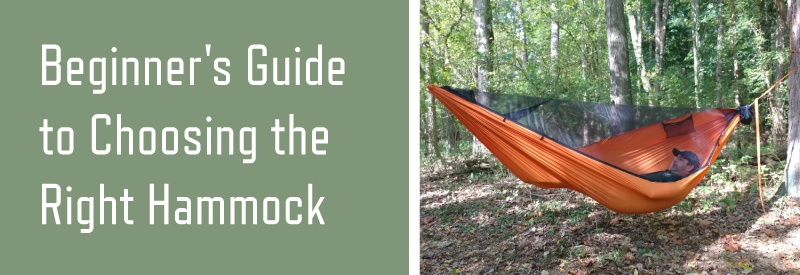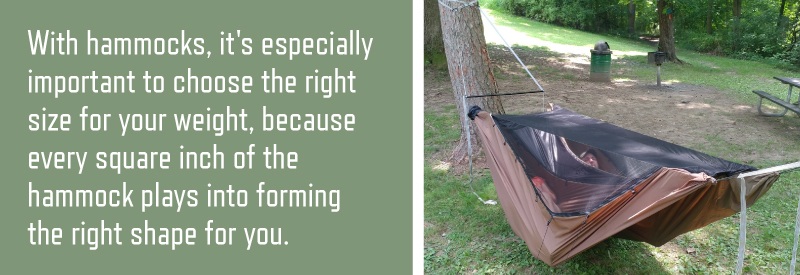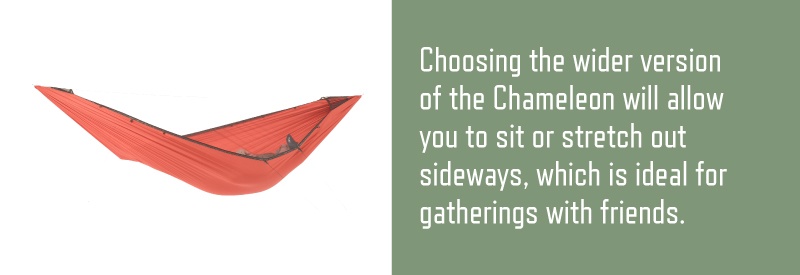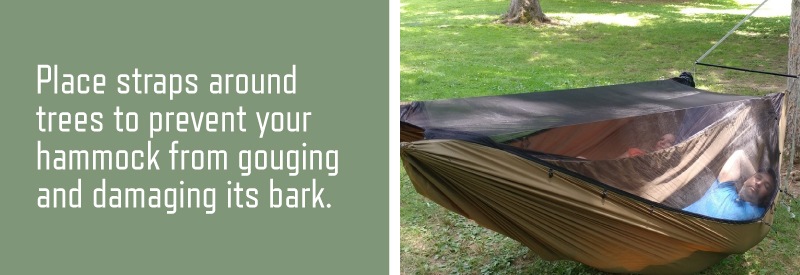February 21, 2019
posted in: Hammock Beginner, Resources

Hammocks have an incredible history. Native people in Central and South America created hammocks to help them stay cool while they slept in the hot, humid environment. In the Galapagos, people slept in “hamacas” woven from tree bark and later from cloth. The hammock allows air to circulate beneath sleepers and carry heat away. Secondly, the hammock suspended its user above the ground. This meant people had less to worry about regarding poisonous snakes, stinging insects and other dangers. Today, modern users enjoy the hammock for many of the same reasons.
Buying your first hammock is an exciting moment! It’s a small piece of equipment that slips into any backpack without trouble. And yet despite its unobtrusive size, it can turn any pair of trees into your kingdom of comfort.
When you go about choosing your first hammock, you’ll want to take a few considerations into account. There are things like the main purpose of the hammock, the type of weather and temperatures you’re likely to experience, your height and weight, what range of activities the hammock might be used for and much more. This article is here to help guide you through the process and help you make a perfect choice.
Table of Contents
Why Buy a Hammock?
We assume you don’t need to be told why hammocks are so awesome — lightweight materials, breathability, versatility in different types of weather and temperatures, natural air conditioning and being off the forest floor, to name a few — but there are some lesser-known reasons why they are so enduring.
For example, imagine thru-hiking the Appalachian Trail. You won’t always have a camp-friendly patch of smooth, flat ground when it’s time to call it a night. Backpackers appreciate the ability to camp anywhere they want, whether it be on rocky terrain or atop a mountain. As long as you have two trees, a hammock makes that possible.
Also, sleeping in a hammock is more comfortable than making your bed on a forest floor. You’ll feel more rested, and a lot less achy, when it’s time to hike on. Consider falling asleep in a stuffy, hot tent or a hammock, breathing cool, fresh air under a star-filled sky. You’ll feel better when you wake up in a hammock because you will have spent the night cradled by nature.
Lastly, if you’re worried you won’t have bug protection, think again. You can equip your hammock with bug netting to keep you free of scratching and swatting in the middle of the night.
What to Consider When Purchasing Your First Hammock
You’ll want a hammock designed to fit your lifestyle and comfort needs, so consider a few factors before you shop.
1. Intended Use
Your hammock should be appropriate for your use. For example, a hammock for sleeping on hiking trips will be more durable than one for lounging by an outdoor pool.
The material will tell you more about its quality and intended use. Go with a hammock made of polyester or nylon if it could get wet. A cotton hammock will serve you well for occasional use in mild climates.
2. Size and Weight Limits
Hammocks come in two sizes — single and double. A single-size hammock is suitable for one person, and a double leaves enough room for two.
Most single hammocks support upwards of 300-400 pounds, and double hammocks can support up to 500 pounds. Single hammocks are typically 8 to 12 feet long, while double hammocks range from 10 to 12 feet.
3. Suspension Accessories
Some hammocks are compatible with reinforced suspension straps and accessories. Strong suspension straps enable you to relax above the ground safely. Make sure the hammock you are interested in works with your suspension technology. Pay attention to the suspension straps’ material, weight limits, and corrosion resistance.
Camping or Lounging Hammocks?
The first question you should ask yourself is what you’ll want to use your hammock for. There are two schools of thought here:
- Camping: A camping hammock is used in place of a mattress pad, tent and sleeping bag for camping trips. Whether you want to sleep outside in the woods behind your house or go for an extended camping trip, a hammock provides the chance to get off the ground and experience the great outdoors in a unique way. Camping hammocks are generally outfitted with different bells and whistles — zippers, accessory packages and design features — that make them ideal for comfortable overnighting.
- Lounging: Chances are good you’ve lounged in a hammock before. Here, the requirements are less strict. Lounging hammocks can be made of a multitude of materials and are generally better suited for reading, relaxing, napping and spending time with friends. While one could technically sleep in a lounging hammock, the fact that camping hammocks are specifically designed for comfort and sleeping means it’s wise to choose a camping hammock for sleeping.
Let’s go into a bit more depth on each of these choices below.
Camping Hammocks

If you are interested in hiking, camping or another outdoor activity that takes you off the beaten path, a camping hammock is recommended. A camping hammock is designed to let a person sleep “flat” — that is, not bent at the waist as with a typical lounging hammock. The material is made to be sturdy and comfortable. Additionally, a camping hammock should not let too much air through to avoid chilling.
If you are considering backpacking for extended distances, you will likely prioritize weight above all else. If you are planning on using the hammock for camping alone, durability is going to be the key factor.
An excellent choice for your first camping hammock is the Chameleon. This has quickly become an industry standard for hammock camping due to its full-featured design, which incorporates all of the needs of campers. The hammock is adaptable to a wide range of temperatures, making it perfect for camping in different seasons.
You can also modify it through different components and add-ons. Whether you are looking for pockets for storage, top covers or other accessories, this hammock is decked out for long-term modification and usability. It is truly the only hammock you will ever need — a pretty good promise for a beginner hammock.
Lounging Hammocks
Hammocks for lounging live by a less stringent set of principles, as they must perform a less rigorous task. They should still be lightweight, breathable and durable, though — and Dutchware’s netless hammocks are up to the task.
These feature hammock bodies that are sewn into a single- or double-layer hammock. The suspension is customizable. All four sides of the hammock are hemmed, and the ends feature triple-sewn channels. These hammocks come in two sizes — 58 inches wide and 11 feet long, or 70 inches wide and 11 feet long, providing plenty of room for stretching out.
Can’t make up your mind between a lounging or a camping hammock? Luckily, you don’t have to. A netless hammock can easily be made ready for a camping trip with bugnets and socks. Also, a netless hammock still features plenty of conveniences like a stuff sack with double ends and different materials to choose from for your comfort. NylonD, which is made from nylon, is soft to the touch and strong against ripping. Dobby has a checkered design and is made from nylon and polyester — it is also resistant to stretching. Finally, Hexon is a durable fabric that offers three weight classifications and many color options.
Knowing Your Height and Weight

Have you ever slept in a bed that was too small? It’s about as comfortable as wearing your childhood jacket. With hammocks, it’s especially important to choose the right size for your weight, because every square inch of the hammock plays into forming the right shape for you.
When it comes to the hammock’s physical dimensions — that is, height and breadth — your options will be fairly limited. However, this is nothing to worry about, as most people fit comfortably into an 11-foot hammock. You may be interested in choosing between a standard and a wide hammock, though. This feature is offered in the netless and Chameleon hammocks and is useful for those who require a bit more room. A wide hammock provides an extra 12 inches of space for taller people to stretch out.
Of more immediate importance is buying the correct hammock for your weight. Dutchware Gear hammocks offer a selection of different materials, each rated for a different weight. The Chameleon is one example. This hammock offers the following options for body fabric, which are weight-rated as follows:
- Hexon 1.0: This fabric features a 200-pound weight rating
- Hexon 1.6: A slightly stronger weave that features a 350-pound weight rating
- Hexon 2.4: The strongest available, with a 400+ pound weight rating
- NylonD Wide 1.7: This is an excellent silky, wide fabric, with a 300-pound weight rating
- Hexon Wide 1.6: Strong, cotton like, wide fabric with a 350 pound weight rating
- TrueTimber: Offers a 325-pound weight rating
It’s generally wise to choose a hammock that has a higher weight rating than you need. For instance, if you weigh 200 pounds, it’s better to buy a hammock in the next weight category up. This allows room for extra sleeping garments, storage items and sufficient strength for sitting down suddenly on the hammock without straining it.
In summary, a hammock is generally a “one size fits all” type of operation. Certain hammocks offer wider spans, but the main consideration that you must pay attention to is weight. The added benefit is that this helps narrow down your choices when shopping, preventing option overload.
Choosing a Hammock That Allows You to Progress
If you are buying your first hammock, you may not want to feel forced to choose between lounging and camping. Perhaps you would like a hammock that can do a bit of both while you figure out how it fits into your lifestyle.

In this case, look for a hammock like the Chameleon that offers comfort and easy setup. Choosing the wider version of the Chameleon will allow you to sit or stretch out sideways, which is ideal for gatherings with friends. Additionally, the Chameleon allows a range of laying positions that are perfect for reading, napping or just enjoying the afternoon breeze.
Hammocks for lounging and camping don’t always have to be mutually exclusive. Check out Dutchware’s large selection of quality hammocks to find one that can accommodate any type of activity you choose.
What Accessories to Use With the Hammock You Choose

Whether you’re napping on a sunny afternoon or camping for the night, you’ll want to check out some of the accessories available for hammocks. Many of these are the result of innovation by Dutchware Gear and offer new levels of convenience:
- Bugnet: A must-have for hammock camping in the summertime and a divine luxury for lounging and reading, the bugnet is a lightweight addition that’s easy to attach. Made with Nanoseeum, Dutchware hammock bugnets are fitted with a shock cord and lock that make attachment to the hammock effortless.
- Sock: Hammock socks come in summer and winter varieties. Summer socks work best with a ridgeline and come in either 10- or 11-foot lengths. Socks can be rotated to adjust the amount of venting and heat retention and include an excellent DWR to protect the quilt. Winter socks also include a Nanoseeum panel that allows for complete adjustment — from generous venting to complete coverage. Both socks work with ridgelines, and both are lightweight for easy travel.
- Suspensions: There are many different ways to hang a hammock, but at Dutchware, we like to keep it simple. For example, our Titanium Beetle Buckles are versatile buckles that leave other suspension pieces in the dust. Their wings allow for easy tension and release and the anchor connection allows you to disconnect the suspension entirely. There are many other options, such as whoopie hooks which allow you to turn two single hammocks into one double hammock but works just as well alone. The Marlin Spike Hitch Complete Suspension set lets you use the marlin spike hitch and toggle method for lightweight attachments. Finally, the Tato Gear Hammock Stand is the easiest way to set up your hammock anywhere you wish, no trees required.
- Ridgeline: Ridgelines are great for holding up tarps or attaching bug nets or top covers. There are two types of ridgelines, adjustable and fixed, which serve different purposes. Adjustable ridgelines come either as Universal Constrictor Rope or Whoopie Slings, and titanium Ridgeline Biners allow you to disconnect it without hassle. Fixed ridgelines come slightly shorter than the length of the hammock — about 83 percent, to be exact.
- Double ended stuff sack: A lightweight, waterproof double ended stuff sack lends a helping hand when hanging a hammock, and it makes hammock-packing fast and easy.
If all of the hammock accessories confuse you then feel free to read our hammock camping checklist here.
Beginner’s Guide to Hammock Camping
Once you’ve chosen your hammock, it’s time for a quick refresher on how to properly use it. Here are some quick tips for hammock camping:

- Protect the trees: Place straps around trees to prevent your hammock from gouging and damaging its bark. Polyester is a great material for hammock straps and should be around 1.5 inches wide.
- Shoot for 30 degrees: How much should your ropes angle downward? The rule of thumb is 30 degrees. Resist the temptation to go too tight — this can put a deceptively large amount of force on the trees and make the hammock wobbly.
- Learn to love the deep sag: You want your hammock to sag pretty significantly in the middle. Though this might look like a nightmare for your spine, it will actually allow you to sleep comfortably, when you…
- Lie diagonally in the hammock: Yes — this is the secret for hammock sleeping that has somehow managed to elude most people who have lain in hammocks. Lie at a diagonal, and you will sleep as straight as a board.
- Use an under-quilt: Air circulation is a blessing, especially when it’s muggy outside. However, hammocks are so good at this that they can chill you at temperatures below 70 degrees Fahrenheit. Use a sleeping pad or under-quilt to stay warm. An under-quilt is suspended beneath the hammock, whereas a pad is placed inside the hammock. If it’s warm, a thin blanket will do.
Use Dutchware As Your Hammock Buying Guide
No matter what style of hammock you choose, Dutchware offers the best quality, durability, breathability and value on the market. We are a one-stop-shop for all your DIY gear needs and hammock needs. Our innovations have spurred progress in the hammock and camping industries, and we are happy to be at the center of the movement.
Our no-knot hardware makes setting up hammocks easier. We also reduce the weight with cutting-edge materials, rope and webbing. Our products are ultra light, high-quality, innovative and easy to use. Just peruse our website to see why we are one of the most trusted names in hammock camping.

